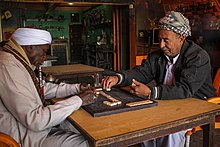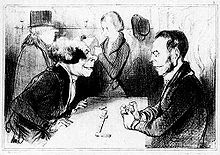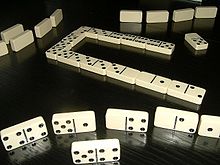domino



Domino is a placement game with mostly 28 (see below) rectangular pieces, mostly made of wood or plastic. Professional game pieces generally have a size of approximately 56 × 28 × 13 mm. The stones are divided into two fields on which between zero and depending on the size of the set up to 18 eyes are shown in all possible combinations. According to the highest number in the game, a distinction is made between double 6s, double 9s, double 12s, double 15s and double 18s domino sets. To make the game easier, the numbers on different fields are often colored differently.
history
The origin of the domino game is unclear. Chinese roots and the import of the stones by Marco Polo are suspected, but cannot be proven with absolute certainty. The name at least suggests monastic origins, as it can come from that long black cloak that was jokingly referred to as domino , or from benedicamus domino , the victorious cry of a passionate abbot.
In the 1990s, the first domino specialist and satire newspaper Das Schwarze Auge appeared in Switzerland , edited by Grand Master (GM) Beat Melcher.
The first German domino sports club “FIDO Deutschland e. V. “was founded on August 22nd, 2004 in Hagenow .
rule
The basic rule of most domino games is to alternate stones with fields of the same number. The player starts with the highest double stone (e.g. in a double 6 domino with 6/6) after the stones have been shuffled face down and distributed. Depending on the number of participants, stones are left over to form the talon . If you cannot land, you pull two stones from the talon or you can skip as soon as it is used up. Whoever has placed all the stones first is the winner. The numbers of the other stones of the other players are credited as plus points. Some variants are also played with a "divisor". In this case the player receives additional points if, after his turn, the sum of the eyes at all ends of the domino line can be divided by the divisor without a remainder. Common divisors are:
- 6 dominoes: Divisor 5
- 9 dominoes: Divisor 5
- 12 dominoes: Divisor 7
- 15 dominoes: divisor 9
- 18 dominoes: divisor 11
Example: If in a game with the 12 dominoes the sum of the free ends in the domino queue is equal to 21 after a player has placed his stone, he receives 21 by 7 = 3 bonus points.
As with playing cards and dice, many different games can be played with dominoes. The winner is usually whoever has put down all his stones first. Some variants are called:
- Hungarian dominoes (You can moor as long as you can. Only then is it your opponent's turn)
- Italian dominoes (the sum of the eyes of two stones plays a role)
- French dominoes (the stones are not placed next to each other, but on top of each other, leaving one half visible)
- Bukidomino , a game of chance widespread in Vienna at the beginning of the 20th century .
- Domino Whist , a variant of block domino for four players in two partnerships
- Pai Gow , a 32-stone game of Chinese dominoes available in casinos in the United States, Macau and Australia
- Dominosa , a solo performance, invented by OSAdler, the anhängte the initials of its name, is similar to a Patience .
- Bilderdomino , a children's version with a picture print, mostly intended as an educational game .
In addition, many card games have been adapted for playing with dominoes, e.g. B. Poker , Twenty One , Euchre , Cribbage , Auction Pitch (under the name "Forty Two" ), Pinochle , Bézique (under the name "Bingo" ), Loo , Hearts , ..., as well as patience .
These games were mainly developed in the American Bible Belt , because there playing cards are frowned upon as " the devil's prayer book ", but the game with dominoes is (just) tolerated. Conversely, the approach known from domino games is also found in certain card games, for example in Fan Tan , which is therefore also known as card domino .
Dominoes are played with four players in the Caribbean (see Domino Whist ). Similar to German Skat , it is important to remember which stones were laid out by which player. If you play this version of dominoes, you can see relatively quickly that this is no longer child's play. The aim is to be the first to put down your stones. In clockwise order, each player places a stone, if it can be placed at all. If not, you have to sit out until you can moor.
African Dominoes does not designate a form of domino game , but game dice with sharp, i.e. not rounded edges, which are used in craps .
Math
The number of pieces is the triangular number of so if the highest number present in the game is.
In a game with a maximum number of pips, a certain number is combined with all values from to , one of which is combined with itself. The number of stones with the same number is therefore the number of stone halves .
If the maximum number of pips is even, then the number of stone halves with the same number is even. Only in this case is it possible to put all stones together to form a closed ring. This means in particular that the stones of the large domino (9) cannot be put together to form a ring. There are at least five stones left.
The total number of eyes of all game pieces is calculated from
This results in:
|
|
tactics
- Most games are about placing a stone with the same number on one half. Stones with two identical halves (“Pasch”) only have one possibility of placing them, so it is harder to get rid of them than others. So you should try to put them on as quickly as possible.
- If, at the end of the game, another player is credited with the remaining eyes on his own hand, it makes sense to give preference to stones with many eyes if there are no other indications for a different decision.
- If the number of stone halves already laid out results in a number together with those on your own hand n + 2, there are no stones with this number in the talon or with other players. If you lay out a stone so that both ends have the same number of pips, you can, because no one else can lay down, put on another stone with this number. If you place the last such stone, the game ends immediately in most types of game.
Math brain teasers
In such tasks, predefined figures are to be formed in which the sums of the eyes in the resulting rows and columns (and sometimes also diagonals) are the same or meet another condition. In addition, there can be restrictions on which dominoes can be used for the task.
Skill game
Dominoes can be placed on their narrow side, whereby they are then in a stable but sensitive equilibrium . This means that such a domino can be knocked over slightly, causing neighboring stones to fall ( domino effect ). This process is used to make a whole row or area of stones built in this way fall over by hitting a single stone. The game of skill does not consist in dropping the stones, but in setting them up.
For this game, stones without an eye print are often used. If the stones are colored in different colors, interesting graphic effects result when they fall.
Domino world champion
A decentralized FIDO Domino World Championship takes place at the end of each year. When groups of five players come together, they play three rounds of a domino game of twelve on divisor seven. The results of the three games are sent to FIDO, where the evaluation is carried out and the world champion is announced on the following day.
Previous domino world champions
- 2019: Hege Lofthus, Norway
- 2018: Max Nolting, Germany
- 2017 : Frank Amling, Germany
- 2016: Nick Nolting, Germany
- 2015: Hans Moskopp, Germany
- 2014: Jürgen Polley, Germany
- 2013: Guðný Ósk Scheving, Norway
- 2012: Chris Wehren, Switzerland
- 2011: Hege Lofthus, Norway
- 2010: Thomas Caflisch, Switzerland
- 2009: Thomas Egeli, Switzerland
- 2008: Guðný Ósk Scheving, Iceland
- 2007: Alex Joss, Switzerland
- 2006: Marina Despotovic, Switzerland
- 2005: Irène Bader, Switzerland
- 2004: Walti Bader, Switzerland
- 2003: Ingo Rickmann, Germany
- 2002: Verena Huser, Switzerland
- 2001: Luzia Würsch, Switzerland
- 2000: Walti Bader, Switzerland
- 1999: Roland Behring, Germany
- 1998: Frank Lindemann, Germany
- 1997: Roswitha Siedelberg, Germany
- 1996: Sigrid Sagevik, Norway
- 1995: Anne Marie Hartvigsen, Norway
Maria Theresa Cup
The second most important annual competition event in European domino sport after the World Cup is the Maria Theresa Cup, which was first played in 2002 in Hochdonn, Schleswig-Holstein, before the European Championship. Since then, it has taken place in late summer in Kollow (Schleswig-Holstein), Hagenow (Mecklenburg-Western Pomerania) and Schwarmstedt (Lower Saxony).
Standardization of dominoes

here the different stones of the double 6 dominoes as SVG
Since version 5.1 of April 2008, the tiles of the double-6 dominoes in horizontal and vertical design as Unicode block dominoes (Domino Tile Symbols U + 1F030 - U + 1F093 ) have been part of the Unicode standard and thus also of the ISO / IEC 10646 standard . Bricks of other variants have not been standardized there (in version 10.0 from 2017).
100 characters for 28 stones
The code block contains 100 different characters , although, as calculated above, a double-6 domino game consists of only 28 different stones. Seven of them have an identical number (0 | 0 to 6 | 6) in the two halves. The remaining 21 stones can be placed with the larger number first or with the smaller number first (e.g. 5 | 2 or 2 | 5). Since rotations in the character coding cannot be mapped trivially, a separate character is used for both options. In addition, each domino has a back that is coded separately. That gives 7 + 21 + 21 + 1 = 50 characters. If you also differentiate between horizontal and vertical alignment, you get 2 × 50 = 100 characters.
Computer representation
There are two different approaches to representation. Either the stones are displayed as graphics or you use a font that includes the Unicode block. Graphics are usually used in computer games. The characters are more suitable for use in texts or tables. Fonts which include the Unicode block are e.g. B. BabelStone Han, Code2001, DejaVu Sans (all variations), Everson Mono , FreeSerif, HanaMinA, Noto Sans, Quivira, Segoe UI Symbol and Symbola.
Dominoes in art

The game of dominoes has also inspired many artists: Honoré Daumier wrote a well-known caricature of domino players. In the first scene of Umberto Giordano 's opera Fedora , Count Andreevich's servants play a game of dominoes.
See also
bibliography
- Fritz Beck: Dominoes in many varieties ( Perlen-Reihe . Vol. 656). Pechan-Verlag, Vienna et al. 1960.
- Michael Engel: The great Humboldt Domino Book. Many variations, oriental dominoes, one-person games and much more (= Humboldt-Taschenbuch. Vol. 4030 Freizeit & Hobby ). Humboldt-Verlag, Baden-Baden 2004, ISBN 3-89994-030-X .
- Miguel Lugo: How to Play Better Dominoes. Sterling Publishing, New York NY 1998, ISBN 0-8069-8299-3 (formerly Competitive dominoes ).
- Albert H. Morehead, Richard L. Frey, Geoffrey Mott-Smith: The New Complete Hoyle . The authoritative guide to the official rules of all popular games of skill and chance. Revised edition. Doubleday, New York NY 1991, ISBN 0-385-24962-4 .
- Reiner F. Müller: Learn dominoes while playing. Basic rules and variations (= Falken-Bücherei 2045). Falken-Verlag, Niedernhausen / Ts. 1994, ISBN 3-8068-2045-7 .
- David Pritchard (ed.): The great family book of games. Nikol-Verlag, Hamburg 1996, ISBN 3-930656-47-7 .
Web links
Individual evidence
- ↑ Fédération Internationale de Domino (FIDO): World Championship. In: www.dominospiel.de. Retrieved January 18, 2020 .
- ↑ Domino (FIDO): World Championship . In: Fédération Internationale de Domino (FIDO) . ( dominospiel.de [accessed on January 21, 2018]).
- ↑ Fédération Internationale de Domino (FIDO): World Championship. In: www.dominospiel.de. Retrieved December 12, 2016 .
- ^ Hannoversche Allgemeine Zeitung, Hanover, Lower Saxony, Germany: King of the stones comes from Garbsen - HAZ - Hannoversche Allgemeine. In: Hannoversche Allgemeine Zeitung. Retrieved December 12, 2016 .
- ^ Maria Theresa Cup













